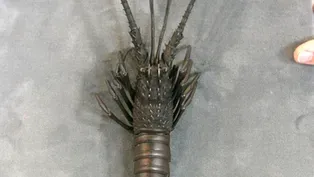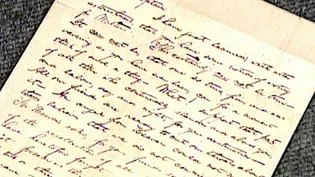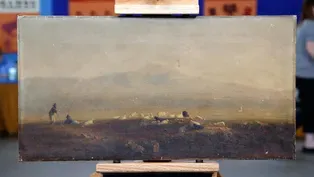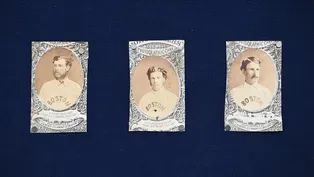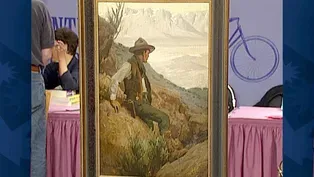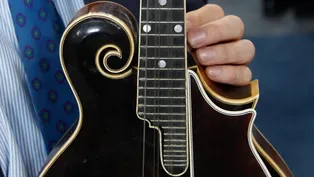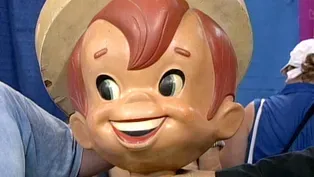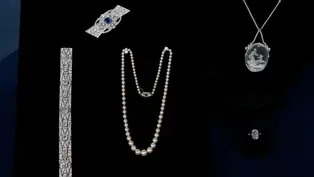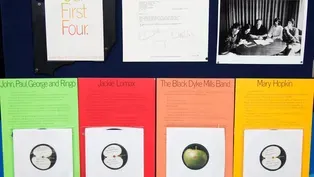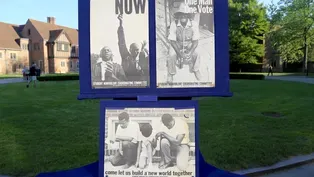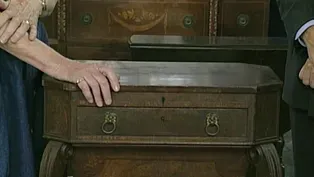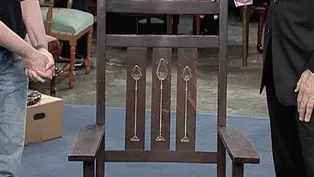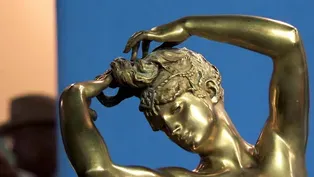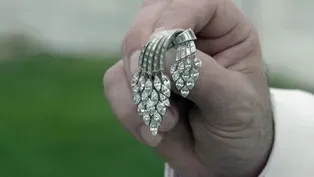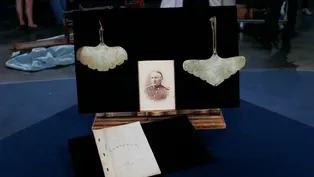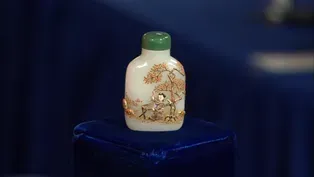
Best of 25
Season 25 Episode 25 | 52m 16sVideo has Closed Captions
Celebrate 25 years with some of our best appraisals ever including a $1 million find!
Celebrate 25 years of ROADSHOW with some of our best appraisals from the last two and a half decades like a Sanford Robinson Gifford oil, a Rolex Oyster Cosmograph, and an 1871-1872 Boston Red Stockings archive. Which is valued at $1,000,000?
Problems with Closed Captions? Closed Captioning Feedback
Problems with Closed Captions? Closed Captioning Feedback
Funding for ANTIQUES ROADSHOW is provided by Ancestry and American Cruise Lines. Additional funding is provided by public television viewers.

Best of 25
Season 25 Episode 25 | 52m 16sVideo has Closed Captions
Celebrate 25 years of ROADSHOW with some of our best appraisals from the last two and a half decades like a Sanford Robinson Gifford oil, a Rolex Oyster Cosmograph, and an 1871-1872 Boston Red Stockings archive. Which is valued at $1,000,000?
Problems with Closed Captions? Closed Captioning Feedback
How to Watch Antiques Roadshow
Antiques Roadshow is available to stream on pbs.org and the free PBS App, available on iPhone, Apple TV, Android TV, Android smartphones, Amazon Fire TV, Amazon Fire Tablet, Roku, Samsung Smart TV, and Vizio.
Buy Now

ANTIQUES ROADSHOW 2025 Tour!
Enter now for a chance to win free tickets to ANTIQUES ROADSHOW's 2025 Tour! Plus, see which cities we're headed to!Providing Support for PBS.org
Learn Moreabout PBS online sponsorship♪ ♪ CORAL PEÑA: "Antiques Roadshow" is celebrating our silver jubilee anniversary with some of the best appraisals from the past two-and-a-half decades.
This is the type of thing that makes them weak in the knees.
Are you serious?
PEÑA: It's "Antiques Roadshow: Best of 25."
♪ ♪ Time flies when you're having fun telling the stories of America's treasures.
Had you any idea that this, this kind of very humble-looking book would, would be worth so much?
PEÑA: Over the past 25 years, "Antiques Roadshow" has seen some memorable appraisals...
This is one of the finest pieces of Federal furniture that I've ever seen.
So you really made my day and Leslie's day... (appraiser chuckles) ...by bringing this.
PEÑA: Some showstoppers...
It is the greatest archive I have ever had at the Roadshow.
(chuckling): Really?
PEÑA: And some that knocked us off our feet.
(people laughing) PEÑA: Settle in as we take a walk down memory lane.
Hold on to your seat... PEÑA: And visit some of our best appraisals of the past 25 years.
That's amazing.
That's absolutely amazing.
APPRAISER 1: Can you tell us a little bit about how you first came to own this fine sewing table?
Well, I'm an antiquer from a long time ago.
Okay.
And that was my love, always just scouring the antique shops.
When I saw it and I saw the hairy paw feet, I just lit up because I knew I had seen it somewhere in one of the antiques magazines.
Well, it was actually made by Duncan Phyfe.
Duncan Phyfe.
Exactly, in New York.
Mm-hmm.
About 1805 or 1810.
And it's probably one of his greatest masterpieces.
It is?
Duncan Phyfe, as you may know, came from Scotland in the late, latter part of the 1700s, around about 1798, and had a huge group of wealthy clients who he made furniture for-- some of the wealthiest merchants in New York at the time.
This is one of the finest pieces of Federal furniture that I've ever seen.
So you really made my day and Leslie's day... (chuckles) ...by bringing this.
This top with canted corners, this rectangular top, opens up and it reveals this wonderful writing area.
This has an adjustable board with the original red baize and gold-tooled leather.
So it's so incredible that that's survived in this condition.
And over on the side, you have this removable mahogany tray for pens with a pewter-covered inkwell.
All the secondary woods here are mahogany.
It's incredibly made, with these very fine dovetails.
Look how, how fine... And on the front of the piece, you have a drawer fitted with these Regency-style lion's head brass pulls, probably made in London and imported here into New York.
And this drawer actually, if you pull this out, you can see the wonderful poplar, typical New York wood, on the underside, which is very green when it's unoxidized.
Oh.
The construction's so tight that even though this is from 1805 or 1810, there's no oxidation-- it's really quite incredible.
These flanking legs, cabriole legs, with roundels here, with molding in the front and these hairy paw feet, and they're raised on their original brass casters.
The finish on it is so wonderful and untouched, and I'm so glad you never-- you never cleaned it.
No, some things you know not to.
APPRAISER 1: Exactly.
APPRAISER 2: Do you realize that, what the value of this is?
It's big money.
You think it's-- certainly in the five figures, right?
WOMAN: Oh, yeah.
Okay.
Well into the five figures, right.
Yeah, without any trouble, yeah.
APPRAISER 1: Well, this, this sewing table is probably worth in the area of around $100,000, and it could bring even higher.
APPRAISER 2: On a good day.
APPRAISER 1: In excess of, on a good day, over $120,000.
Well, all these wonderful things you've said... APPRAISER 2: Thank you.
...I felt, when I saw it in the antique shop, I knew it was one of these wonderful things.
Right-- you mentioned earlier that antiques have helped change your life and possibly save you from an illness you had.
Well, I had cancer 23 years ago, and if I hadn't, hadn't had the hobby of antiquing, I think I would be gone now.
But antiques have kept me, the running and looking for them, the finding and researching, it just carries you all the time-- it lifts you.
You have no time to get sick or die.
You really don't.
Well, you lifted us, and thanks for bringing this today.
MAN: This is a letter that is written to Andrew McCormick, who was my great-great-grandfather, and it was written to Abraham Lincoln in 1841.
I don't think I've ever seen an Abraham Lincoln letter of such feeling.
It is absolutely one of the most emotional Lincoln letters you'll ever see.
You always think of Lincoln as being so calm and steady and sedate-- even the handwriting in this letter is agitated and almost angry.
Obviously, Lincoln was writing to someone who was a close friend, because he signs it just "Lincoln," not "A. Lincoln," not "Abraham Lincoln."
Lincoln is writing to your great-grandfather... Mm-hmm.
...about a man by the name of William Walters, who was up for reelection in 1841.
And Abraham Lincoln did not like him one little bit, because one of his dear friends was running against him-- Simeon Francis.
And Abe Lincoln wanted Simeon Francis to win this reelection.
Mm-hmm.
Not the person that apparently your great-grandfather was going to be voting for.
Let me just read a few of the lines here.
"I have just learned with utter astonishment "that you have some notion of voting for Walters.
"This certainly cannot be true.
"It cannot be that one so true, "firm, and unwavering as you have ever been can for a moment think of such a thing."
A Lincoln letter of an early date, from January 1841.
It's not dated, but we're able to find out when Walters was going to be reelected in the context of the letter.
The condition of the letter is absolutely pristine.
Something like this would be in the ballpark of $75,000 to $125,000 at auction.
(chuckling) Whew.
Whoa.
APPRAISER: What do you think of that?
Fantastic.
I had no idea.
APPRAISER: And you're keeping it... And this belongs to my 18-year-old son right now, so... Well, your 18-year-old son has something very wonderful to keep in the safe deposit box.
It's an absolutely wonderful piece of Americana.
WOMAN: I saw an ad in a paper.
It says, "An estate sale."
And I thought, "I'd better check this out."
This was just about 30 years ago.
APPRAISER: Okay.
And I walked in, and my eyes spotted this magnificent majolica fountain.
And you had to have it.
And I had to have it.
It's made by the English firm of Minton.
And there was a man named Minton who had traveled through Europe.
And going through the French region of Rouen in 1849, he found a type of semi-opalescent glaze that he wanted to put on his wares.
He went back and instructed his factory to start making these wares.
Now, some of the best artists of the time were commissioned to create sculptures and designs which he incorporated into his fountains.
Each piece of majolica, especially from this time period, is marked with a date cipher.
So if we look on the bottom here, you will see that triangle and cross conform to the year 1862.
Oh, yes.
See how marvelously it's, it's modeled.
Yes.
Down here at the bottom.
Yes.
You have the beautiful mask, and the foliate festoons, terminating in mask handles.
It is just a fantastic piece of majolica.
It's wonderful.
Now, I noticed that there was a monogram here.
Yes.
Did you have a story about that at all?
Yes, yes.
I was told that it was made for Alfred, Lord Tennyson, the poet.
The story goes that he had returned from Italy, and at that time he had been made the poet laureate.
Right.
And this was a presentation to him from his neighbors.
It's certainly a possibility.
What we can say for certain is that it's just about as good a piece of majolica as you're going to find.
Really?
It's just wonderful.
Let me ask a question.
How much did you pay for it 30 years ago?
$300.
Did you really?
(laughing): Yeah.
Do you know how much it's worth now?
Tell me.
It's worth probably about $30,000 to $50,000.
Yow!
(laughs) It's a wonderful piece.
Yes.
And I understand you use it as a planter.
Yes.
Well, keep good plants in it, for goodness's sake.
(laughing): Orchids.
There you go, perfect.
APPRAISER: The doll was only in production for approximately about a year, and there's probably about maybe ten of them known to exist anywhere.
Oh, my God.
I would put him in the, on the cheap side at $12,000 and the high side at $17,000, so... Wow, that's...
Your relative had a neat piece.
Yes.
It's way, way cool.
Thank you.
It was exciting seeing him.
No moths near him.
No, no, no.
MAN: Take much better care of him now.
(all laughing) APPRAISER: Your ancestor, John Armstrong, was with St. Clair in Ohio.
This is his wallet with "continental" embossed on it, and these are very rare.
And this was his powder horn.
It's got wonderful wear, and covered with this hide.
And this was a little pocket pistol of his.
I think this is $25,000 to $35,000 worth of material.
Oh, my goodness.
The common thing that happens with this book is, it gets rubbed off, and every time it's put on a shelf.
MAN: Yeah.
So the gilding gets worn away.
In this case, it's in perfect condition.
That makes a big difference from a collecting point of view.
A beat-up copy of this book might sell for $1,000, maybe $2,000.
But in this condition, because you've preserved it so well, I would go as far as to say that it's worth $10,000 to $12,000.
Right.
Wow.
It's a classic book, and in this condition, I don't know a collector who wouldn't want to own this book.
Yeah, wonderful.
So, congratulations.
APPRAISER: It's by one of the great makers.
It's made by Märklin.
Märklin is the gold standard in toys.
Not many survive, because they'd stay in the water and get rusty.
MAN: My father collected arms and armor, and this was always one of my favorite items.
This object was probably made by a family called the Myochin.
And the Myochin were armorers that used to make armor.
But it turns out, in the middle part of the 19th century, the feudal system collapsed in Japan, and there was no need for these people to do anything.
And what they started to do was make tourist objects like this.
And this is actually made out of iron.
And it's completely articulated and absolutely naturalistic.
This is an exact duplicate of the original little animal.
One of the things you notice is that... Mm-hmm.
...that color is an artificial color that's been put on it to make it look even more natural.
And then, if you reverse the item and you see the bottom of the piece, you can see all the little articulations and moveable parts that would be on a live lobster, but in this case, recreated in iron.
Very, very finely done.
And one reason why I attribute it to the Myochin is, the Myochin were so good that it doesn't seem likely too many other people could've done one of this quality.
I sold another piece that was not attributable to the Myochin-- it wasn't as fine a quality.
And it was a completely articulated dragon.
And dragons are a much, much more common item.
Mm-hmm.
I sold that for $10,000.
Hmm.
I would say a conservative price on this one would be $15,000.
Oh, well, great.
WOMAN: It's my sister's chair.
She purchased it from some friends of mine in the late '70s.
After that, she was looking at an antique trader, noticed another chair in there called a lost treasure.
APPRAISER: Ah.
And realized maybe she had a treasure of her own.
You and your sister both know this is a Gustav Stickley chair.
Yes.
Because it's marked, and we'll look at the mark in just a second.
Right.
Gustav Stickley is known for very scaled-down and simple, heavy furniture.
Well, this is not so scaled-down, because it's got this inlay decoration across the back.
Okay.
And it's also rather light, compared to a lot of his pieces.
The lines are a lot thinner, and the pieces of wood are a lot thinner.
That will tell you this is a special piece.
Harvey Ellis was a designer, he was an Englishman who worked for Gustav Stickley for not much more than a year.
He was an alcoholic, and he died in 1904.
Oh, my.
But he brought this rather decorative European Arts and Crafts style, and it modified Gustav Stickley's more severe look.
And so these inlays which are on the back slats have inlays of pewter, copper, rare woods.
Now, your sister mentioned there was some repair to the inlay?
I believe she said this one was a repair, and possibly a crushed-up penny that was put in there.
It was just kind of flattened out and banged into place?
Flattened-out penny, yeah.
That's not unusual-- it's not the end of the world.
We know it's an early chair because Harvey Ellis died in 1904.
There are other ways we know it's an early piece of Gustav Stickley furniture.
Okay.
If you look inside the chair, you see these holes?
Yup.
This had a cane seat foundation that a cushion would rest on.
Later pieces of Gustav Stickley would have drop-in seats or spring seats.
Furthermore, this piece has an earlier mark on it, which we'll look here.
It's inside of a box, so it's a decal.
When you see a box around the mark, you know it's an earlier piece of furniture.
Another indication that it's early is this finish, which is really beautiful.
And it's, it makes a huge difference in the look, the quality, and the value of the chair.
See the difference of the color between the back of the arm and the bottom of the arm?
Yup.
That's because of normal wear-- that's not a bad thing.
It shows this chair has not been cleaned.
If anybody refinished this chair, they would have evened out the color on the arms.
Okay.
But if we turn the chair around...
The color on the back is this rich, chocolatey-brown fumed finish.
It's really what you want to see on a Harvey Ellis chair and makes a vast difference in price.
Retail, today's market for this chair, $40,000 to $50,000.
Oh, my word-- that's awesome.
Several things would make it worth less.
If it was refinished, $10,000 to $15,000.
(exhales softly) Lighter finish, $25,000 to $35,000.
With this color, $40,000 to $50,000 for this chair.
Oh, my word-- that's awesome.
You've brought in a very interesting group of material today, and it comes from your great-great-uncle, right?
That's correct.
There's a photograph taken, I think towards the end of his career, but he was born in New York, and he moved out to Illinois when he was in his teens, went back east to West Point, where he was a cadet from 1860 to 1865.
Mm-hmm.
After he graduated from West Point, he was with the U.S. Army, and he went out to the Dakotas, Fort Laramie, Fort Kearny, where he studied with the Sioux who were out there.
Mm-hmm.
Well, his work at Fort Laramie is what really interests me.
Fort Laramie was a, a very important post along the Oregon Trail.
It was established as a fur trading post in 1834, and then, with the California Gold Rush in the late 1840s, it became a military post.
Your great-great-uncle happens to have been there at a very momentous time in the history of printing in America.
He printed this book, which is called "Lahcotah," and he signed it here on the cover.
It's a dictionary of the Sioux language-- the rules of pronunciation, et cetera.
And if I just turn to the back... We see that the book was printed in Fort Laramie, Dakota, December 1866, and that W.S.
Starring was the co-author of the book with J.K. Hyer and an Indian interpreter, Charles Guerreu.
Not only is it this printed book, but it's filled with his pencil annotations correcting it, so it makes it a very significant copy of this book, because it's the author's own, and it's with his corrections, very simply bound with these staples.
He also has with it what we call two gorgets, and I've talked to the colleagues on the tribal arts table.
And it would've been worn around the neck on a breastplate, and it carries these decorations.
These happened to be owned by two of the senior-most chiefs of the Sioux Nation in the 1870s, Red Cloud and Spotted Tail.
They tell me conservatively, the value on these would be about $8,000 to $12,000 each.
Each?
Each.
(laughs) But let's go to the book.
This is the first book printed in Wyoming, and collectors of Americana are so passionate about having the first book printed in any of the territories.
Happens to also be about the Sioux language, so it has an extremely important ethnographic interest, as well.
This book at auction I would estimate at $60,000 to $80,000.
For one book.
For this copy, the author's copy with his annotations... (chuckling): Wow.
...the first book printed in Wyoming.
With the other items, for the whole collection, you're looking at an archive value of roughly $100,000 to $150,000.
(laughs) Wow, that's... Had you any idea that this, this kind of very humble-looking book would, would be worth so much?
We were trying to guess, and we, we weren't even close.
That, that's, um...
Uh, that's incredible.
Well, it's a highly significant book.
And I don't know if, if because of the annotations make it worth that much more.
Yes.
We have... We have two more copies, they're not... Only one copy has come up at auction in the last 25 years, and it made $30,000, and that was in 1999.
That was for just a standard copy, and it had some condition problems.
This is easily twice is good.
It's an incredibly rare book.
MAN: They actually originally belonged to my great-aunt Indiola on my mother's side.
Aunt Indiola was married to a gentleman by the name of Clem Keys, who was a very important airline promoter and financier back in the early part of the century.
They lived in high-society circles in New York, and I believe that's where my aunt acquired them.
Later passed them on to my mother and eventually to me.
What we have here are a number of very interesting examples of what we consider Art Deco jewelry.
This is a engraved rock crystal and seed pearl and diamond necklace.
It's engraved in a neoclassical scene.
This here is an Art Deco bracelet encrusted with diamonds; a brooch with a Ceylon sapphire and a diamond openwork design.
The pearls here are natural pearls, which are very sought-after in the 1920s, with a diamond clasp.
And last, in front here, we have a diamond ring.
Now, your diamond ring is unique.
It's a large stone.
It's an elongated rectangle with cut corners.
This stone fits under the category of diamonds that we refer to as Golconda, from India.
And with Golconda stones, they have a particular phenomenon that occurs to them-- when they are exposed to light, when they're in daylight, they get super-white.
Most diamonds are graded on a scale of D through Z, but even a Golconda would be a D-plus in terms of color-- it would be high, high up there.
These stones are white, the light dances in them.
They're very, very sought-after stones.
When you talk to a connoisseur of diamonds, and if you say you have a Golconda stone, this is the type of thing that makes them weak in the knees, basically.
Ah, great.
So, all these pieces date from the 1920s.
The bracelet itself would be mid-1920s to the late 1920s.
Now, there are no hallmarks on the item, but based on the craftsmanship, the type of workmanship, I would tend to think that this piece was American.
The brooch, also-- no hallmarks, but appears to be American, as well.
The pearls, these could be retailed by anybody during this period, and there's nothing indicative that says they're European or American, but more likely than not, since they were in New York, it was manufactured probably in the United States.
The diamond pendant necklace may be European.
This is much more in the European taste.
And in terms of the diamond ring-- there are no hallmarks on that, either-- it was manufactured in the United States, as well.
The first item here, the fair-market value on this would be between $5,000 and $7,000 on the necklace.
Great.
The sapphire and diamond brooch, value on this would be between $10,000 and $15,000.
Wow.
The pearl necklace would be between $20,000 and $25,000.
Whew!
And the bracelet would be between $40,000 and $60,000.
Oh, my.
Now, for the diamond, our valuation for that at auction would be between $70,000 and $90,000.
Wow.
I really appreciate your bringing them in today.
Well, thank you very much.
It's great to hear these kinds of values.
MAN: They hang in my bedroom.
APPRAISER: Great.
They've been there for close to 30 years.
Okay, well...
I've had these a long time.
Okay, starting with the Bob Thaves, at auction, maybe 50, $75, $100.
On "The Wizard of Id," a little bit higher value.
A little bit more recognized.
I would probably estimate that maybe $200 to $400.
Wow!
In that range.
Wow!
This is "Peanuts," Charles Schulz, 1976.
Right.
Great strip-- on today's market, Schulz art is one of the hottest collectibles around.
Really?
Okay.
And I would put a conservative auction estimate of about $3,000 to $5,000 on that piece.
Wow.
(chuckling): Wow.
It's a great piece.
MAN: My grandfather left it for me.
You know what it is?
I have a feeling it's Native American, but that's about all I know.
I expect that it's Sioux or Cheyenne.
Yeah?
It's an incredible pipe.
I mean, these guys, they didn't have anything till they got horses from the Spanish, and then they became the most powerful culture on the Plains.
Really?
And so horses were really important to them.
This has got to be one of the most elegant, beautiful horse pipes I've ever seen.
What the pipe's made out of is catlinite.
And catlinite has always been the top material for stone pipes from the Plains.
Probably dates to the Indian Wars, the 1870s, maybe a little earlier.
But I guess you want to know what it's worth.
Sure.
Well, I knew you were excited about it, so that got me excited.
(laughs) Yeah.
$4,000 to $6,000.
Really?
Yeah.
Wow.
You got left something really important and really beautiful.
It's like a piece of sculpture.
Oh, it's beautiful...
It's more than just a pipe.
WOMAN: It was my in-laws'.
It was in their home for many years.
And when they moved to Florida, they gave it to my husband and myself.
APPRAISER: Bierstadt is one of the most popular Western artists.
It's really superb.
It's beautifully rendered, it's very finely detailed.
It's probably earlier for his work, and generally speaking, you'd like something before 1880, so I kind of think this is probably from 1870.
The other thing that's great about it is, it's in perfect condition.
I would expect a gallery to sell it in the neighborhood of $150,000.
What?
150?
Ooh.
I didn't think it would be worth that much.
I bought this at an auction... Uh-huh.
...about 34 years ago.
Here in Florida?
Yes.
Why did you buy it?
I bought it because I thought she was beautiful.
No other reason.
I knew nothing about it.
Well, this is actually by a very, very famous French artist.
He was primarily a painter.
His name was Jean-Léon Gérôme, and he was probably the leading French artist of the 19th century working in what we call the Academic style.
19th century had an Academic style and then they had the new painters, you know, the Impressionists.
And what year was that?
It was in the 1850s-1860s.
And he specialized in historic scenes: scenes of the Middle East, of Ancient Egypt, of Ancient Greece, and Ancient Rome.
And your figure is interesting because she's actually an Ancient Roman figure.
She has this very exotic headdress in here, but the real giveaway is these shoes that lifts your foot up from the floor.
She was in a bathhouse.
What's unusual about your piece is how large it is.
Most of the pieces by this artist that come to the market are about this big or maybe this big.
It's beautifully cast.
The French at this time were the leading founders.
Wonderful detail.
And this has the original patina, this gold finish.
It's absolutely perfect condition.
Oh, I thought she was beautiful.
Well, what did you pay for it?
$500.
You paid $500?
That's a fair amount of money 35 years ago.
Well, I thought that was expensive.
Uh-huh.
Gérôme's work is very desirable, very highly sought-after.
At auction, this would bring between $30,000 and $40,000.
(exhales) (woman laughs) (laughing) You okay?
Why are you laughing?
I'm amazed.
That's good.
I'm amazed!
Great.
WOMAN: It was purchased by my great-grandfather during the Depression.
He purchased it from, I believe, a neighbor who at the time needed some extra money, and he wanted his son, my grandfather, to learn how to play a musical instrument.
Well, when you walked in with this, I saw the case, I went, "Oh, my God, I know what that is."
(laughs) And I thought, "Well, can it be?"
And I opened up the case and there it was, this wonderful Gibson F-5 mandolin.
I could tell that it was what we call a Lloyd Loar model F-5 with this fern inlay in the peghead.
Okay.
Lloyd Loar was an acoustic engineer and great mandolin virtuoso who worked at the Gibson company...
Okay.
...back in the teens and '20s.
And he really was the father of the modern mandolin.
Okay.
And what he did to make the mandolin what it is today is, he, he did various things to it like, internally, it has parallel tone bars.
Okay.
It has an elevated fingerboard, elevated over the body.
It has two F holes, like a violin, and actually, similar to a violin, it has the bridge positioned around the center of the body, around the center of the arch.
Okay.
And it is arched like a violin and tap-toned, meaning internally tuned.
The thicknesses of the plates inside are tuned like a violin.
Okay.
And Loar was the first guy to do this to a mandolin.
It also has a longer playing length of the neck.
It has 15 frets to the body.
Earlier mandolins had shorter necks.
Gibson had been making these F-style mandolins from turn of the century on, but this innovation in mandolin making was something that Loar excelled in, and this became the, basically the prototype style for all mandolins to come.
It has inside the Gibson label...
Yes.
...with serial number.
As well, on the other side, it's got the master model label.
Now, this was the professional, master-grade mandolin that Gibson put out late 1922...
Okay.
...and onwards.
And these early ones, the ones made while Loar was at the factory from late 1922 through 1924, we call them Lloyd Loar model F-5s.
Okay.
This has the most beautiful what they call Cremona brown sunburst color to it.
If I had to grade it in Gibson mandolins, Lloyd Loar mandolins, I'd probably put it at the top ten percent of the ones I've seen.
Wow.
When did he buy it again?
Um, it-- during the Great Depression.
From what I understand, he paid $20 for it, and at the time, you know, it was estimated probably around $600 is what I'm told.
Right.
I would say, these days, a correct asking price through a dealer in a shop would be about $175,000.
Oh, my gosh!
(laughs) Wow!
It's been in a closet in a farmhouse for many, many years.
(laughs) MAN: In the late '60s, my dad headed up Capitol Records during a time when the Beatles were their major act.
It's also the time when the Beatles were starting a new record label called Apple Records.
I have some memorabilia from that era.
Here is your father... Yeah.
...Paul, and, and who's this guy?
Yeah, that would be me, yeah.
(laughs) And what's great about this photograph, as well, is, it's actually signed by Paul.
And it says, "Love from the Cincinnati District."
So he's making a little joke about his jacket.
Just, just great.
So what are these four here?
Well, this was from a box set that my dad brought home, I think advertising the release of Apple Records.
So it was a promotional set.
It used to come in this really nice plastic box that contained these four different folders.
But the box has since...
I have all the pieces, but they're in shards now.
Each of these have these unopened...
I don't know if they're 33s or 45s, and they look like they've got hand-penned descriptions of "Hey Jude" and the various artists.
Mary Hopkins, I think she recorded "Those Were the Days, My Friends."
What's pretty fascinating about this, the cover of the box here, it's to your father.
Yeah.
"Our first four."
They had a very close relationship, obviously, with your father-- here's a great photo of them with your dad.
Pretty amazing stuff.
Also, you have this wonderful letter here, which is basically a thank you for the gifts that your father sent to them.
And it's dated January 21, 1970.
And what's pretty amazing about that is that literally three-and-a-half months later, the Beatles are no more.
And at this point in their collective life, it's pretty contentious.
They're really not talking to each other much.
And none of us here had ever seen something signed by all four of them dated 1970.
It's incredibly rare.
We think that an insurance value for something like this, the collection, about $60,000.
Excuse me?
$60,000.
Holy mackerel.
WOMAN: This was something that had been essentially lost, buried, put away in our family for 50-plus years.
It was stored down in the basement and then, when my husband's parents passed away, he inherited it.
We've had it for about 25 years, but just had it stored up above the bookshelf at home, and it wasn't until we watched "Antiques Roadshow" quite a bit that I got a little suspicious and went, "I wonder if that's something that's pretty neat."
I think it's pretty neat.
You said that you only could read the date.
Yes, that's all.
We've tried to figure out the artist and couldn't do it.
Well, when you brought it to the table, I took one look at it and I knew who the artist was.
Really?
You said the date was 1868, I do believe, but it's, I think it's 1858.
1858, okay.
And the artist is Sanford Robinson Gifford.
Now, Gifford is a very, very important Hudson River artist.
Really?
He was considered one of the great Luminist painters.
Now, Luminism referred to the landscape painters that saw nature as sublime, and they created this sublime in the light in their paintings.
So the painting is an oil on canvas.
Now, your painting is very dirty.
Yes.
So you couldn't see the signature, which is right here in the lower left, and the date.
Gifford was born in 1823 and he died in 1880.
In the mid-1850s, he went to Europe, and this is a view of Italy.
Really?
We know that, although the mountains look like they could be the Northeast, it's definitely an Italian scene with the Italian shepherds and the ruins in the landscape.
We wondered about that.
Hold on to your seat.
The insurance value would be about $300,000.
That's amazing!
That's absolutely amazing.
We believe that if you had it cleaned, it would certainly enhance your enjoyment of the work.
As far as value goes, if you were thinking about selling it... Uh-huh.
...most collectors would rather see it this way and use their own conservators.
Interesting.
Did you have any expectation of the value when we said, "Do you want to go on TV?"
Absolutely nothing, except I thought, "She knows!
She knows what this is!"
It's signed with every stroke of the brush.
Well, back in 1871, my great-great-grandmother had a boardinghouse in Boston, and she housed the Boston baseball team.
Most of them had come from Cincinnati Red Stockings and were among the first to be paid to play baseball.
Now, all these cards went to your great-grandfather?
That's how he got them and they got handed down to you?
Yeah, apparently he collected them, and he unfortunately cut them down to fit this little album, so they're all slightly askew.
Right.
And the thing that's special, in addition to the cards, is this letter, and they all wrote a little sentence and signed it.
They must have really loved her.
She did-- I'm sure she did the cooking, the cleaning for them.
Because if you read some of these lines here: "I am just going upstairs to supper and feel awful hungry, "but do not expect much-- poor meals here, too hungry to say any more, Harry Wright."
Here we have, "Would that we were home again.
"My sentiments have been expressed "in the above paragraphs-- big meals.
A.G.
Spalding."
Well, what you have here are some of the earliest known 1871 photographic baseball cards.
Harry Wright here and his brother George Wright is here.
You know, these were the original Wright brothers.
(chuckles) Also, Albert Spalding.
Now, Spalding is a very familiar name, isn't it?
Right.
He was the first well-known player to use a fielding glove.
And what did he build from that?
A sporting goods empire.
Mm-hmm.
To have this letter with Harry Wright and Spalding on it is tremendous.
To have anything with their signatures on it is phenomenal, because again, you're talking about the precursor to the National and American leagues.
So, that all said... (laughs) You're going to keep them in the family, right?
I want to, yes.
Okay.
I'm going to value this as an archive, everything here.
If you're going to insure it... Insure it, okay.
...I would insure it for at least $1 million.
Are you serious?
(chuckling): Oh, my.
Holy smokes.
It is the greatest archive I have ever had at the Roadshow.
Really?
Holy smokes.
(chuckles) Guess I better put it in a bank vault.
Mm-hmm.
I have to say, you have hit a grand slam today.
(both laugh) This is a Duffner Kimberly, and it is called the dragon.
These were 1904, 1906.
Okay.
This lamp, not too long ago, was in the $50,000 retail range.
We've come down a little bit to about $35,000.
Okay.
Still a pretty nice lamp.
Yes.
MAN: When I was around eight years old, Cassius Clay lived in our neighborhood, and all the little kids would run around following him and chasing him and mimicking him as he was practicing his boxing.
After he would do that, he would invite us over to his house for hot dogs and Kool-Aid, and we thought that was the best thing in the world.
APPRAISER: This is one of his fighting promotions.
Mm-hmm.
And he personalized it to you.
He wrote, "To Nat, from Cassius Clay."
Yes.
And then he did again in fountain pen, right there on his legs, he wrote, "From Cassius Clay."
So he twice signed this for you.
We think that at auction, this would fetch a price between $5,000 to $7,000.
No way.
Yeah.
$5,000 to $7,000?
Wow.
We'd insure it for considerably more.
We'd insure for about $10,000.
Wow.
Well, golly, I never thought it would be worth $5,000 to $7,000.
It's a great piece.
It's a knockout.
WOMAN: The pin belonged to my grandmother, who lived in Chicago.
I don't know where she bought it.
I don't know what it's worth.
I haven't worn it, and that's, that's all I can tell you, really.
And never had it appraised, did you?
Never had it appraised.
We love people like you when you come in here with that.
(chuckles) Lack of information.
Lack of information, solid lack.
Right.
(laughs) All right, so, first of all, you see, I'm just standing here, and it's moving.
In the wind.
Yeah.
Is that fantastic?
It is lovely.
Imagine if you were dancing in, in 1940, because that's about when I think this pin was made.
Okay.
All right?
Now, we keep referring to it as a pin.
But?
I don't-- I think the pin was added.
I think it was always made to have some type of a chain running through it, and it hung as a necklace.
Not that it doesn't work as a pin.
Okay.
It reminds me of a waterfall.
I mean, the diamonds are truly dripping off of this, okay?
(chuckles) There's a little over two ounces of platinum in the whole piece.
All right?
Then there's about four carats in baguettes.
The marquise-shaped stones, there's a lot of them, and they're all different sizes.
One of them is as large as a carat.
You add them all up, there's nine carats in the marquise diamonds.
So all together, we got 13 carats of goods, all right?
Any thoughts on the piece?
Beautiful.
Beautiful, I like that.
So you really don't need to know what it's worth.
I would like to know.
(laughs) Thought I'd get out of here.
So I would say at auction, $15,000 to $20,000.
Great.
Not bad, right?
Not bad.
Yeah.
For a bunch of rocks.
(both laugh) That's great, I love it.
MAN: I bought them a few years ago from a garage sale.
They were with a number of dorm-type posters.
And I knew I was buying a piece of history, and I knew it was an important piece of history.
But I really haven't had a chance to, to really research them.
I figured they were from the, probably the early to mid-1960s, based on their content.
And how much did you pay for them?
Well, I paid 25 cents apiece for them, and I think they charged me that because they do have some holes and a little bit of, a little bit of wear.
Quite frankly, they have been used.
Mm-hmm.
They have tape marks in the corners where they were taped to the walls.
You'll notice on each, there's a tear, and when they were all rolled together, at some point, they were torn in the same place.
Yeah.
And some animals got to them.
There were little nibbles taken out.
It seems so.
They look like dorm-room posters.
Mm-hmm.
But more than just dorm-room posters.
As you said, they're, they're a piece of history.
And more than just a piece of history, they're a piece of recent history.
They're pieces of the Civil Rights Movement in America.
Now, these three photos were taken by a photographer named Danny Lyon.
Danny Lyon is a very prominent and famous photographer who really made his name by elevating social democratic photography to an art form.
Hm.
This was his milieu-- this is where he shone.
And he did a lot of work with the Student Nonviolent Coordinating Committee, the SNCC, or "snick," as they were known.
And SNCC was part of the Civil Rights Movement that was formed in relation to the sit-ins that began happening in the early 1960s, and within the Civil Rights Movement, they had wanted things to move a little bit faster and a little bit more aggressively.
And these posters were advocating the work of SNCC within the Civil Rights Movement.
They date to around 1962, and the images are these images from marches.
They're images from protests.
The one next to you that says "Now" was taken at the march in Washington, DC, where Martin Luther King gave his "I Have a Dream," speech.
Hm.
Wow.
One of these posters to me stands out more than the other ones.
Mm.
And that's the one on the bottom.
"Come Let Us Build a New World Together."
What to me stands out about it are the people who are involved in the photograph.
Do you recognize any of them?
No, I don't.
I only recognize one, to be honest, and that's the figure closest to you.
That's John Lewis, Congressman John Lewis.
Sure.
Who was then a 22-year-old civil rights activist.
He's been a congressman now for over 30 years, and this was when he was involved in the movement.
So coincidentally, he was caught in this photograph, in this incredibly poignant moment.
Mm.
Praying for a new world together, a better world-- and it's great.
Two of these three posters have come up at auction before, the John Lewis poster and the "One Man, One Vote" poster.
Okay.
The "Now" poster has never come up for auction.
In my estimation, in their current condition, were they to come up at auction, I would estimate these three posters between $7,000 and $10,000.
Okay.
And as I understand it, you paid 75 cents.
Yes, I did.
I'm a little better at history than I am at math, but that's a very good return.
Uh, yeah.
The John Lewis poster came up for sale as recently as March 2018.
The first and only time it's ever come up for auction, and in perfect condition, it sold for $6,500.
Wow.
I'm flabbergasted, I really am.
I collect posters but not these kinds of posters.
So, I guess I did all right.
I brought in a Rolex watch that I had purchased while I was in the military.
I was stationed in Thailand from 1973 to 1975.
And while I was there, I flew on Air America Airlines and Continental Airlines, and I noticed that most of the pilots that were flying those aircraft wore Rolex watches, and I was intrigued by them.
I always wanted to purchase them, but they were very expensive.
Later, when I was transferred to another base, I did some scuba diving, and I knew that the Rolex watch was good for scuba diving.
I found this particular watch where I could afford it, and I never used it.
I looked at it and I said, "You know, this is really too nice to take down in salty water."
Yeah.
I just kept it.
After I got out of the service, I had other watches I wore and I just put this one into a safety deposit box.
It stayed there for 30 or 40 years.
I only took it out, like, two or three times to look at it, and that was about the extent of it before I brought it here.
What branch of service were you in?
I was in the United States Air Force.
I entered in 1971.
My draft number was seven.
That's a pretty low number, huh?
(chuckles) That's not really lucky in the, in the draft, right?
No.
When I found out about that, I either had to join the Air Force or another branch, or I was enlisted by the first of January.
And what'd you do in the service?
I worked in munitions, but there's, like, four different branches, and I worked in explosive ordnance disposal.
To put it simply, I helped clear roads of land mines.
Munitions storage areas that had been blown up or sabotaged, we cleaned those up.
There were... multiple children and adults that were injured as a result of unexploded ordnance.
And it's, the hazard still is there today.
You bought this where?
Was it, was it at a military store?
I ordered it in November 1974 through the base exchange.
I believe it came in in April 1975.
The amount that you paid, you even got a ten percent discount.
It says $345.97.
Was that a lot of money in 1975 to you?
It was a lot of money for myself.
What were salaries back then?
It ranged between $300 and $400 a month, if I have it correct.
As you know, it's a Rolex.
This particular model is referred to as an Oyster Cosmograph.
They're also referred to as Daytonas.
This is a reference 6263.
You saved everything, which is really wonderful.
The warranty paper was never filled out and was never numbered, so you have, actually have a blank guarantee, which is quite unusual.
And even over here, this paper is blank.
A blank paper today is probably worth about $2,000, because it can be made to match any watch and add value to it.
You have the original Rolex brochure here for the Cosmograph.
You have two receipts, the order receipt and your payment receipt.
You have the original box.
Even the outer box here.
These watches, as we've talked on "Antiques Roadshow," have become very collectible and valuable.
It's got a couple of very special features about it.
Underneath the word "Rolex" and above the word "Cosmograph," it says "Oyster," and that refers to these screw-down buttons here.
They made this version with and without screw-down buttons.
The ones without the screw-down buttons are still water-resistant, but this was a much better water-resistant case, because you could lock down the chronograph buttons on it.
It still has the foil sticker on the back with the reference number of the watch, 6263.
Had it be worn, that would be the first thing that would wear off the watch.
The date mark on the bracelet shows that it was made in the first quarter of 1971, and you ordered it a couple of years later.
Collectors love this watch because Paul Newman wore it in a movie called "Winning."
It wasn't this particular model, it did not have the screw-down buttons.
The one that Paul Newman wore, currently at auction, those watches are going for approximately $150,000 to $200,000.
Your watch is more special.
It says... You got to be kidding me.
It says "Oyster" on it.
Yes.
They did that for an extremely short period of time.
We refer to that as a Mark II dial.
And this particular model, being marked "Oyster," is extremely, extremely rare.
A watch like this at auction is worth about $400,000.
(people laughing in background) You okay?
(people laughing) (chuckles) Don't fall.
I'm not done yet.
I said, "A watch like yours."
Because of the condition of it-- basically, it's a new old stock watch: no wear on it; the original foil sticker on the back of it; and the fact that we have all this complete documentation here, also-- your watch, at auction, today, $500,000 to $700,000.
You got to be (muted) me.
(laughing) No, I'm very serious.
(chuckles and murmurs) It's an absolute fabulous find.
It's one of the rarest Paul Newman models, and in this condition, I don't think there's a better one in the world.
I can't thank you enough for bringing me one of the greatest watches to ever see on "Antiques Roadshow."
And thank you very much for your service.
Unbelievable.
You can't wear it, though.
(murmurs) If you wear it, it drops down to the $400,000 value.
BARRETT: It was in Milwaukee, 1998.
It's exciting when you're sitting at the table and you're waiting for something to come in, you see the crowd, and all of a sudden you see something above people's heads that comes up to my table and I'm just... (exhales) I mean, you know, once in a while, you get something that just knocks you, knocks your socks off, and this did.
I was working at a bakery in Los Angeles in 1969, and my supervisor told me to throw all the junk out of the attic that was in the bakery.
So I threw all this stuff out in a dumpster, with the exception of Speedy.
I thought he was kind of cute and thought I'd take him home.
What you have here is an absolutely wonderful advertising figure.
I've never seen this particular size before, and it is absolutely astounding.
I would expect that a collector today would be thrilled to pay $4,000 to $5,000 for this incredible Speedy the Alka Seltzer.
Well, he's as good as gone.
(laughs) What's that?
He's as good as gone.
(both laugh) People always ask, do you ever get a chance to buy that stuff on the "Roadshow"?
And one of the rules for sure is, we cannot buy anything at the show, we cannot offer any money to somebody there.
But I've had people call up after the show and say, "Would you like to put it in your auction?"
"Absolutely."
Don't think I've ever had somebody call me up and say they want to sell it.
Well, it did happen.
About six months later, the guy called me up, and he said, "Hi, you know, I'm the guy with that Speedy.
"It's December, I could use some Christmas money.
Is there any chance you'd want to buy that?"
I said, "Yeah.
I really loved it."
Now, 1998, I thought an auction estimate would be $4,000 to $5,000.
We talked about it, and we came up with a price somewhere in that range.
I honestly can't remember.
Now, today's market, you know, it's like a lot of things on the "Antiques Roadshow," or a lot of things in the antiques world.
Things have softened up, and I think today, if I had this at auction, I would probably estimate it at, like, $2,000 to $3,000.
A little bit less than I paid for it.
But I don't care, I love it.
It makes me smile every day.
♪ ♪ PEÑA: Thanks for watching.
See you next time on "Antiques Roadshow."
Appraisal: Meiji Period Iron Spiny Lobster
Video has Closed Captions
Preview: S25 Ep25 | 1m 45s | Appraisal: Meiji Period Iron Spiny Lobster (1m 45s)
Appraisal: 1841 Abraham Lincoln Letter
Video has Closed Captions
Clip: S25 Ep25 | 2m 11s | Appraisal: 1841 Abraham Lincoln Letter (2m 11s)
Appraisal: 1858 Sanford Robinson Gifford Oil
Video has Closed Captions
Clip: S25 Ep25 | 3m 19s | Appraisal: 1858 Sanford Robinson Gifford Oil (3m 19s)
Appraisal: 1862 Minton Majolica Fountain
Video has Closed Captions
Clip: S25 Ep25 | 2m 19s | Appraisal: 1862 Minton Majolica Fountain (2m 19s)
Appraisal: 1871-1872 Boston Red Stockings Archive
Video has Closed Captions
Clip: S25 Ep25 | 2m 38s | Appraisal: 1871-1872 Boston Red Stockings Archive (2m 38s)
Appraisal: 1912 Maynard Dixon Oil Painting
Video has Closed Captions
Clip: S25 Ep25 | 1m 2s | Appraisal: 1912 Maynard Dixon Oil Painting (1m 2s)
Appraisal: 1924 Gibson F-5 "Lloyd Loar" Mandolin
Video has Closed Captions
Clip: S25 Ep25 | 3m 11s | Appraisal: 1924 Gibson F-5 "Lloyd Loar" Mandolin (3m 11s)
Appraisal: Alka-Seltzer "Speedy" Figure
Video has Closed Captions
Clip: S25 Ep25 | 2m 20s | Appraisal: Alka-Seltzer "Speedy" Figure (2m 20s)
Appraisal: Art Deco Jewelry, ca. 1920
Video has Closed Captions
Clip: S25 Ep25 | 3m 15s | Appraisal: Art Deco Jewelry, ca. 1920 (3m 15s)
Appraisal: Beatles Records & Letter, 1970
Video has Closed Captions
Clip: S25 Ep25 | 2m 23s | Appraisal: Beatles Records & Letter, 1970 (2m 23s)
Appraisal: Danny Lyon SNCC Civil Rights Posters, ca. 1962
Video has Closed Captions
Clip: S25 Ep25 | 3m 29s | Appraisal: Danny Lyon SNCC Civil Rights Posters, ca. 1962 (3m 29s)
Appraisal: Duncan Phyfe Sewing Table, ca. 1805
Video has Closed Captions
Clip: S25 Ep25 | 3m 7s | Appraisal: Duncan Phyfe Sewing Table, ca. 1805 (3m 7s)
Appraisal: Gustav Stickley Inlaid Armchair, ca. 1904
Video has Closed Captions
Clip: S25 Ep25 | 2m 34s | Appraisal: Gustav Stickley Inlaid Armchair, ca. 1904 (2m 34s)
Appraisal: Jean-Leon Gerome Sculpture
Video has Closed Captions
Clip: S25 Ep25 | 2m 8s | Appraisal: Jean-Leon Gerome Sculpture (2m 8s)
Appraisal: Platinum & Diamond Waterfall Pin, ca. 1940
Video has Closed Captions
Clip: S25 Ep25 | 1m 50s | Appraisal: Platinum & Diamond Waterfall Pin, ca. 1940 (1m 50s)
Appraisal: W.S. Starring Archive, ca. 1870
Video has Closed Captions
Clip: S25 Ep25 | 3m 25s | Appraisal: W.S. Starring Archive, ca. 1870 (3m 25s)
Appraisal: Chinese Jade Snuff Bottle, ca. 1880
Video has Closed Captions
Clip: S25 Ep25 | 34s | Appraisal: Chinese Jade Snuff Bottle, ca. 1880 (34s)
Providing Support for PBS.org
Learn Moreabout PBS online sponsorshipSupport for PBS provided by:
Funding for ANTIQUES ROADSHOW is provided by Ancestry and American Cruise Lines. Additional funding is provided by public television viewers.


